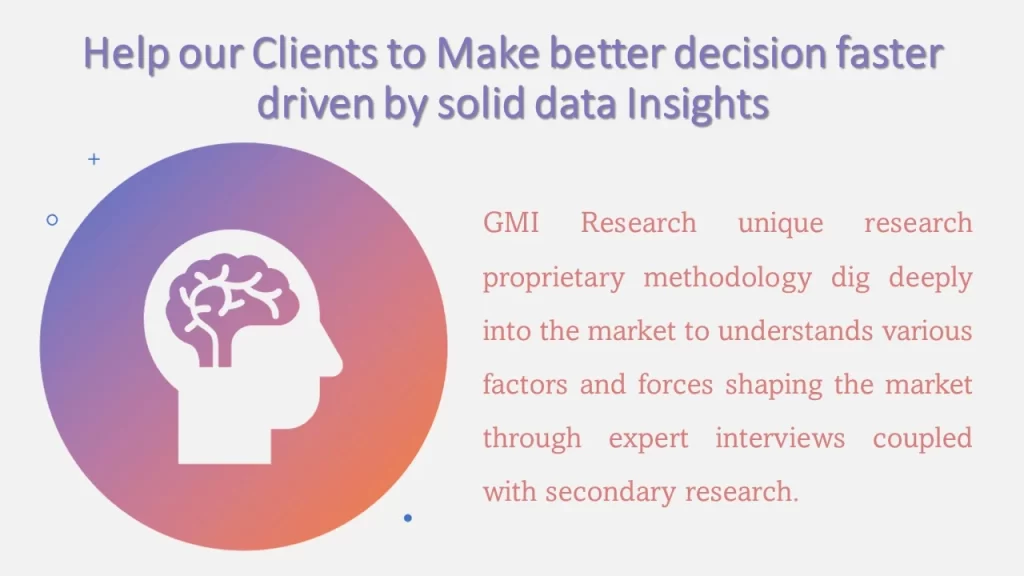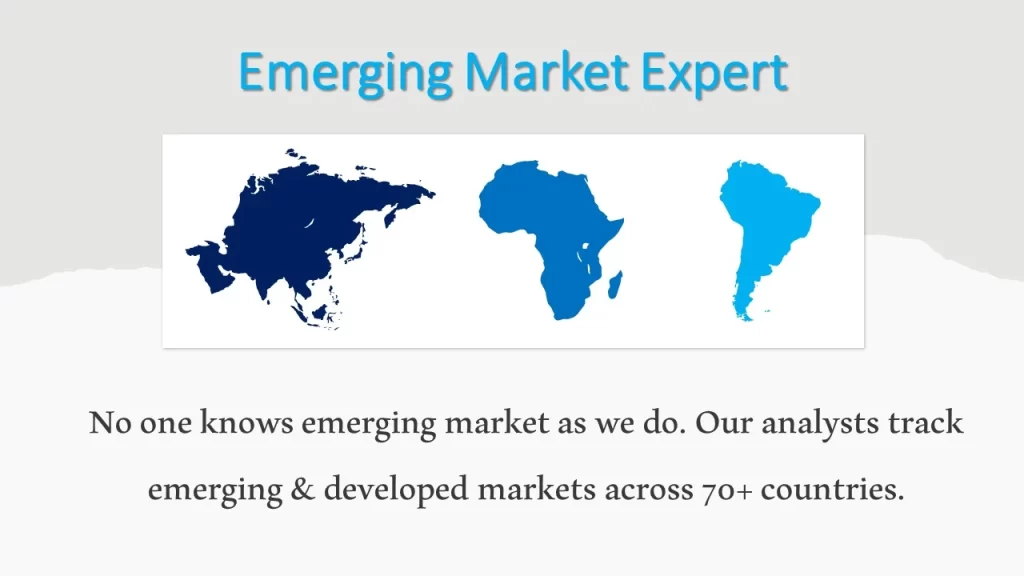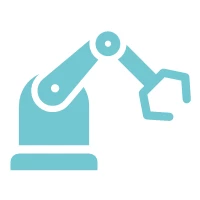3D Printing Robot Market Size, Share, Trends and Growth Report – Global Opportunities & Forecast, 2023-2030
3D Printing Robot Market size reached USD 1.5 billion in 2022 and is estimated to reach USD 4.3 billion in 2030 and the market is estimated to grow at a very high CAGR of 14.1% from 2023-2030.
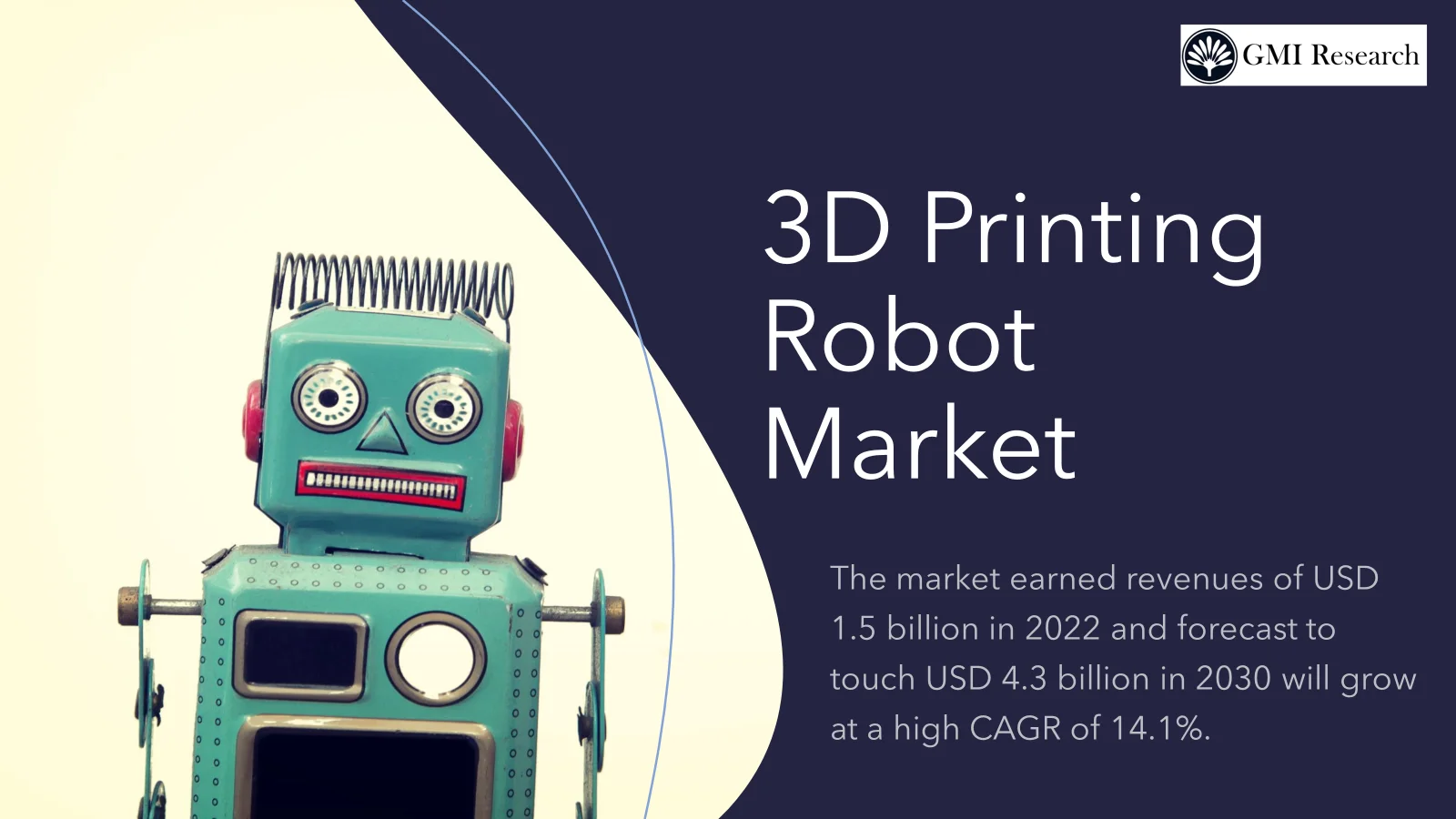
To have an edge over the competition by knowing the market dynamics and current trends of “3D Printing Robot Market” request for Sample Report here
Major 3D Printing Robot Market Drivers
The global 3D printing robot market is projected to be propelled due to a significant rise in the need for automation, growth in different research and development activities, and increase in government funding in different additive manufacturing developments. The rising demand for automation in industries such as aerospace, automotive, consumer goods, and healthcare is driving the employment of 3D printing robots. These robots play an important role in automating the manufacturing process, decreasing the intervention of human beings, developing effectiveness, and confirming consistent quality. In addition, the progress in materials and technology is fostering the evolution of increasingly sophisticated 3D-printed robots. Researchers are examining the usage of innovative materials including carbon fibers and eco-friendly plastics to increase the functionality and strength of these robots. Moreover, the incorporation of artificial intelligence and machine learning and autonomy of these 3D printed robots.
Presently, the 3D printed robots market is witnessed a rise in government funding and an increase in collaborations among manufacturers, researchers, and technology organizations. These collaborations and investments focus on introducing advanced and practical applications for 3D-printed robots. In addition, the market is competitive due to the entry of more players, resulting in a wider spectrum of robot designs and applications. However, government funding in additive manufacturing projects plays a significant role as a driver for the 3D printing robot industry. Recognizing the transformative capability of this technology, governments globally are assigning significant resources to drive its development and adoption. In 2023, data from the Association for Manufacturing Technology stated an annual growth rate of 36.7% in global venture capital investment in additive manufacturing organizations. In 2022, this investment reached USD 1.853 billion, building on the significant momentum witnessed in 2021, which saw an additional USD 514 million in funding. These investments include a variety of initiatives, including research and development programs and infrastructure development. The primary objectives of these initiatives are to propel innovations, economic competitiveness, employment opportunities, and address challenges within the industry. Governments across the globe have been strongly funding and incorporating different programs focused on 3D printing research and development and the integration of 3D printing technologies in different end-user industries.
The potential of 3D printing to revolutionize healthcare deceits in their ability to introduce patient-specific medical devices, implants, prosthetics, and anatomical models. This technology ensures developing patient care and developing treatment outcomes. Additionally, the automotive sector get advantage from the customization expertise of 3D printing robots. These effective robots can be engaged to produce customized car parts, prototypes, and tooling, leading to a deduction in both time and costs compared to traditional manufacturing approaches. Furthermore, in the construction industry, 3D printing robots are significantly helpful in constructing complex building components, architectural structures, and affordable housing. This technology holds the potential to transform the construction procedure, making it more efficient, faster, and eco-friendly. The market expansion is projected to present a growth in construction companies in developing nations, an increased prominence on environmentally friendly techniques, and the growing need for cost-effective housing solutions. Governments globally, with regional authorities and organizations, actively encourage innovation in foremost industries through initiatives including the National Science Agenda, innovative industrialization, Innovation Attache Network, Innovation Expo, and National Icons Competition programs. In addition to all this, 3D printing robots have potential to modernize the construction of aerospace elements by decreasing weight, developing design elasticity, and developing complete performance. Furthermore, this technology can facilitate on-demand production and restoration of critical parts in the defense sector.
Do you want to know more about the Research process and detailed Methodology, Request Research Methodology of this report
Meanwhile, the 3D printing robots industry faces challenges in the form of huge installation costs. This financial load incorporates not only the considerable initial investment for acquiring the robots but also additional expenses, including infrastructure adjustments, software integration, and the training of skilled personnel. This results in a challenge for small and medium-sized enterprises, as the associated costs can seem formidable, limiting their ability to hold this advanced technology. The continuous functional expenses connected to repair, maintenance, and the procurement of specialized materials further contribute to the overall ownership costs. These continuous financial possibilities can stretch the reserves of businesses, specifically those functioning in highly competitive markets with narrow profit margins.
Whereas, the significant rise in awareness concerning the higher degree of autonomy proposed by 3D printing robots than the outdated and conventional printers is predicted to led a growth in market opportunities. Specialized robotic arms equipped with a high degree of independence characterize 3D printing robots, reshaping the 3D printing landscape by revealing the potential for complex and intricate structures. Contrary, conventional 3D printers are constrained to three degrees of independence, limiting their movement along the axes including X, Y, and Z. Unlike conventional 3D printers restricted to three degrees of freedom, 3D printing robots usually feature at least 5 degrees of independence. This prolonged variety allows them to move with additional rotations across all three axes. This enhanced agility empowers these robots to access and print complicated information that was challenging to accomplish in the history.
The future outlook for the 3D printed robot market appears promising due to the considerable rise in demand for automation, and robotics in different industries, including healthcare, logistics, and manufacturing. The fascination of 3D printed robot for businesses comes from different benefits, including accelerated production, the capability to craft custom designs, and cost-effectiveness. These factors make 3D-printed robots an attractive choice for companies looking to automate their functions. Continued technological innovations and the expanding adoption of automation in industries are predicted to propel an increased need for 3D-printed robots. This trend introduces new opportunities for producers and propels further revolution in the field.
In case, any of your pain points areas are not covered in the current scope of this report, Request for Free Customization here
Robot arms segment captures the largest market size in the global market
Robot arms contribute to 3D printing in different ways, offering precision, increased speed, and the capability to handle complex, larger parts, thereby decreasing labor costs, and developing safety. They decrease the requirement for support structures, develop surface finishes, and automate post-processing tasks. For instance, in 2023, Rapid Robotics entered into a partnership with Yaskawa America, Inc. to widen its variety of industrial robotic arm solutions. This integration focused on increased speed, enhanced performance, and high payload potential for producers in North America.
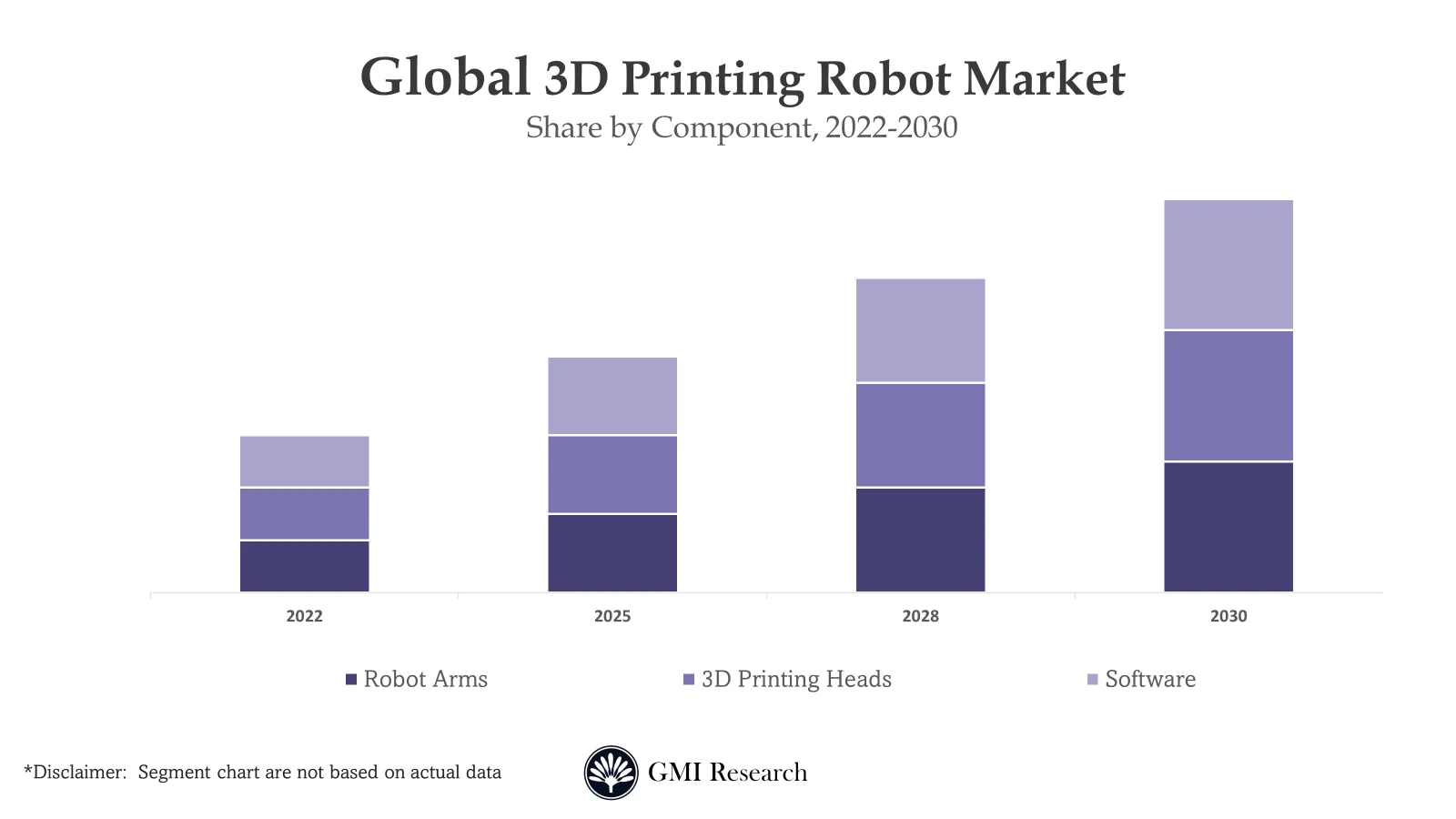
Articulated robots segment accounted for the highest revenue share in the global market
The articulated robot segment is predicted to witness a steady growth because these robots are chosen for their versatility and precision, playing an important role in manipulating 3D printing nozzles or tool heads with complex movements. The ability to produce customized and complex objects is facilitated by this capability. Articulated robots are specifically utilized in applications that require intricate and precise designs. Their contribution lies in developing the effectiveness and confirming high-quality output in 3D printing processes. Their ability allowed them to direct complex geometries and introduce comprehensive structures. When paired with 3D printing head, articulated mechanical arms enable more extensive and flexible 3D printing procedures. Additionally, articulated robots exhibit compatibility with different 3D printing technologies, including wire arc additive manufacturing for metal and pellet prominence for pellet-derived printing. The rapid improvement of 3D printing robots, especially in the construction industry, is driven by their scalability. Collaborations between suppliers of robotic arms and third-party 3D printing professionals look to innovate and commercialize different large-scale additive manufacturing approaches.
Asia Pacific 3D Printing Robot Market dominated the global market
The Asia Pacific region is predicted to witness the fastest growth rate in the 3D printing robots market. Including nations such as South Korea, Japan, China, and the Rest of Asia Pacific, the region has observed substantial traction for 3D printing robots in different aerospace, FMCG, automotive, and construction industries, transforming the introduction of parts with increased effectiveness and precision. In particular, Japan has evolved as a leading integration of 3D printing robots within the construction sector, propelled by different key factors.
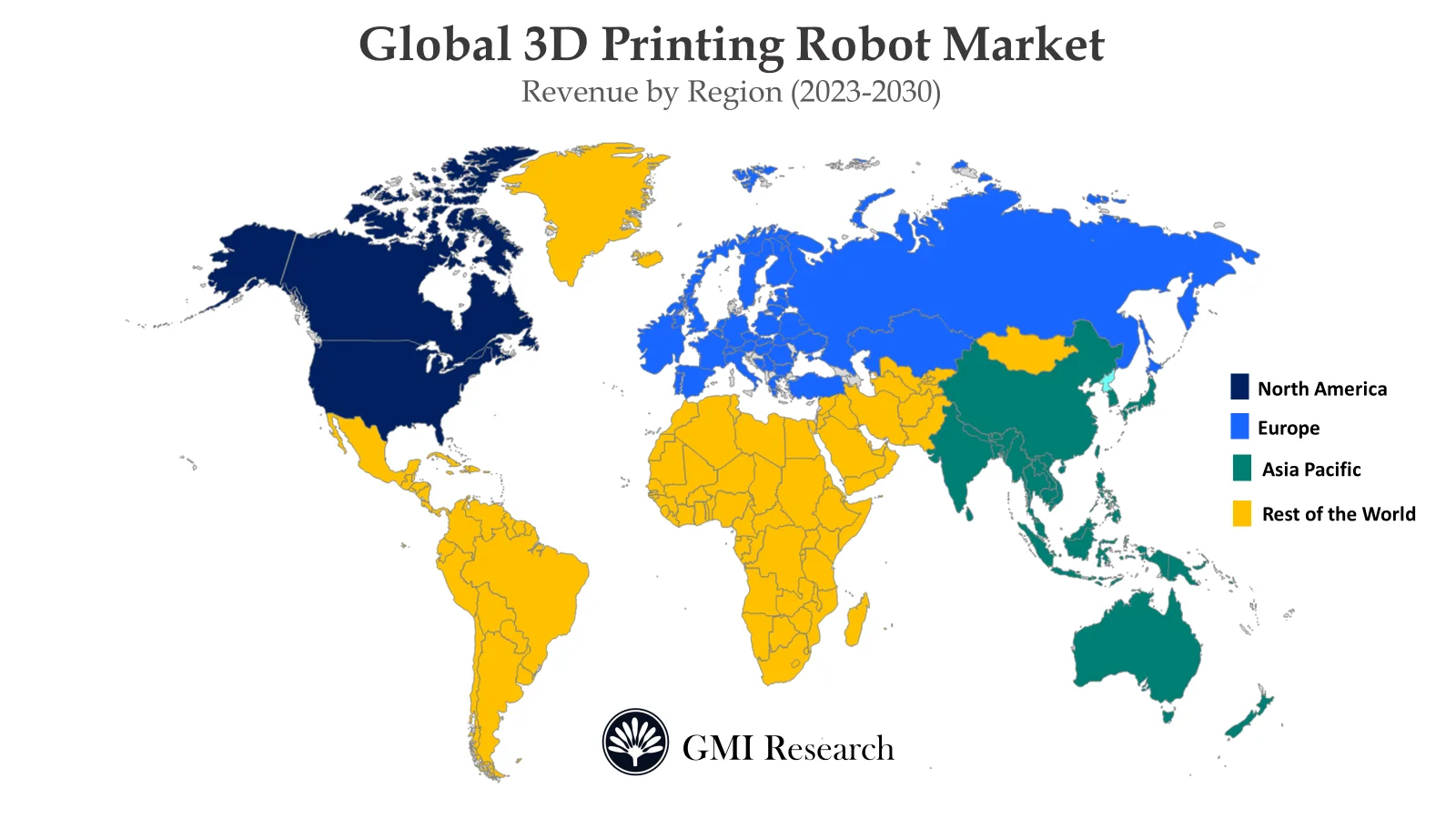
Top Market Players
Various notable players operating in the market include KUKA AG, ABB, Yaskawa Electric Corporation, FANUC CORPORATION, Universal Robots A/S, Massive Dimension, CRAD B.V., Caracol, WEBER Maschinenfabrik, Meltio3D, Comau, Baubot, MX3D, Twente Additive Manufacturing among others.
Key Developments
-
- In 2023, Meltio announced the launch of Meltio Robot Cell to foster the functioning of industrial robotic arms in a more reliable, safer, and highly exact manner to control the complete procedure.
- In 2023, Massive Dimension joined hands with ABB to fulfill the growing demand of different end-user industries and being competitive in the global market.
Segments covered in the Report:
The Global 3D Printing Robot Market has been segmented on the basis of Component, Robot Type, Application and End-user Industry. Based on the Component, the market is segmented into Robot Arms, 3D Printing Heads, Software. Based on the Robot Type, the market is segmented into Articulated Robots, Cartesian Robots, Scara Robots, Polar Robots, Delta Robots, Other Robot Types. Based on the Application, the market is segmented into Prototyping, Tooling, Functional Part Manufacturing. Based on the End-user Industry, the market is segmented into Automotive, FMCG, Aerospace & Defense, Construction, Culinary, Others.
For detailed scope of the “3D Printing Robot Market” report request a Sample Copy of the report
|
Report Coverage |
Details |
| Market Revenues (2022) |
USD 1.5 billion |
| Market Base Year |
2022 |
| Market Forecast Period |
2023-2030 |
| Base Year & Forecast Units |
Revenues (USD Billion) |
| Market Segment | By Device, By System, By Application, By Region |
| Regional Coverage | Asia Pacific, Europe, North America, and RoW |
| Companies Profiled | KUKA AG, ABB, Yaskawa Electric Corporation, FANUC CORPORATION, Universal Robots A/S, Massive Dimension, CRAD B.V., Caracol, WEBER Maschinenfabrik, Meltio3D, Comau, Baubot, MX3D, Twente Additive Manufacturing among others; a total of 14 companies covered. |
| 25% Free Customization Available | We will customize this report up to 25% as a free customization to address our client’s specific requirements |
Market Segmentation
Global 3D Printing Robot Market by Component
-
- Robot Arms
- 3D Printing Heads
- Software
Global 3D Printing Robot Market by Robot Type
-
- Articulated Robots
- Cartesian Robots
- Scara Robots
- Polar Robots
- Delta Robots
- Other Robot Types
Global 3D Printing Robot Market by Application
-
- Prototyping
- Tooling
- Functional Part Manufacturing
Global 3D Printing Robot Market by End-user Industry
-
- Automotive
- FMCG
- Aerospace & Defense
- Construction
- Culinary
- Others
Global 3D Printing Robot Market by Region
-
-
North America 3D Printing Robot Market (Option 1: As a part of the free 25% customization)
- By Component
- By Robot Type
- By Application
- By End-user Industry
- US Market All-Up
- Canada Market All-Up
-
Europe 3D Printing Robot Market (Option 2: As a part of the free 25% customization)
- By Component
- By Robot Type
- By Application
- By End-user Industry
- UK Market All-Up
- Germany Market All-Up
- France Market All-Up
- Spain Market All-Up
- Rest of Europe Market All-Up
-
Asia-Pacific 3D Printing Robot Market (Option 3: As a part of the free 25% customization)
- By Component
- By Robot Type
- By Application
- By End-user Industry
- China Market All-Up
- India Market All-Up
- Japan Market All-Up
- Rest of APAC Market All-Up
-
RoW 3D Printing Robot Market (Option 4: As a part of the free 25% customization)
- By Component
- By Robot Type
- By Application
- By End-user Industry
- Brazil Market All-Up
- South Africa Market All-Up
- Saudi Arabia Market All-Up
- UAE Market All-Up
- Rest of world (remaining countries of the LAMEA region) Market All-Up
-
Global 3D Printing Robot Leading Market Players (Option 5: As a part of the free 25% Customization – Profiles of 5 Additional Companies of your Choice)
-
- KUKA AG
- ABB
- Yaskawa Electric Corporation
- FANUC CORPORATION
- Universal Robots A/S
- Massive Dimension
- CRAD B.V.
- Caracol
- WEBER Maschinenfabrik
- Meltio3D
- Comau
- Baubot
- MX3D
- Twente Additive Manufacturing
Related Reports
- Published Date: Dec-2023
- Report Format: Excel/PPT
- Report Code: UP3614-001001
Licensing Options
Single-User License:
The report is used by the purchaser (One Individual) only
Multi-User License:Report is shared with maximum 5 users (employees) including the purchaser of the purchasing corporation only
Corporate License:
Report is shared with unlimited user (employees) of the purchasing corporation only
The report is used by the purchaser (One Individual) only
Multi-User License:Report is shared with maximum 5 users (employees) including the purchaser of the purchasing corporation only
Corporate License:
Report is shared with unlimited user (employees) of the purchasing corporation only
3D Printing Robot Market Size, Share, Trends and Growth Report – Global Opportunities & Forecast, 2023-2030
$ 4,499.00 – $ 6,649.00
Why GMI Research

